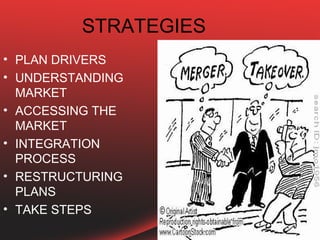PPT on merger & acuqisitions
- 2. PRESENTATION BY Shipra Sharma MBA
- 3. CONTENTS 1. Historical phase 2. Introduction 3. Types & diffrences 4. Objectives & benefits 5. Problems & Solutions 6. Comparitive analysis 7. Examples with analysis 8. Recent tech mahindra merge 9. Conclusions.
- 4. History • The concept of merger and acquisition in India was not popular until the year 1988. During that period a very small percentage of businesses in the country used to come together. • The key factor contributing to fewer companies involved in the merger is the regulatory and prohibitory provisions of MRTP Act, 1969. • According to this Act, a company or a firm has to follow a pressurized and burdensome procedure to get approval for merger and acquisitions.
- 5. *The year 1999 tnessed one of the oldest business acquisitions or company mergers in India. It is the well-known ineffective unfriendly takeover bid by Swaraj Paul to overpower DCM Ltd. and Escorts Ltd Volume is tremendously increasing with an estimated deal of worth more than $ 100 billions in the year 2007. This is known to be two times more than that of 2006 and four times more than that of the deal in 2006 As for mow the scenario has completely changed with increasing competition and globalization of business. It is believed that at present India has now emerged as one of the top countries entering into merger and acquisitions
- 6. MERGER It refers to the aspect of corporate strategy, corporate finance and management dealing with the buying, selling, dividing and combining of different companiess and similar entitiess Through it can help an enterprise grow rapidly in its sector or location of origin, or a new field or new location, without creating a subsidiary, other child entity or using a joint venture.
- 7. Acquisition Acquisition-It is the purchase of one business or company by another company or other business entity. Acquisitions are divided into "private" and "public“. Acquisitions, depending on whether the acquire or merging company (also termed a target) is or is not listed on public stock market.
- 9. DIFFERENCES MERGER ACQUISITIONS • Retain name & brand. • It can’t retain • Mutual benefits *Saving from the loss • NO loss of cooperate • Usually loses culture. cooperate culture. • Nothing altered the • Negative employes behaviour. consequences on the • Responsibilities can employee. assign but leadership • Payroll & problems. responsibilites equally not distributed.
- 10. OBJECTIVES & BENEFITS ECONOMIES MARKET PATENT OF SCALE SHARE RIGHTS ELIMINATION DESIRED OF TO ENJOY COMPITIOTION MONOPOLY ADAPTION OF M&A MODERN ECONOMY TECHNOLOGY OF SCOPE EFFECT OF OTHERS TRADING SYNERGY
- 11. TYPES OF MERGING 1. Vertical Merger. 2. Conglomerate Merger 3. Horizontal Merger
- 12. EXAMPLES OF DIFFERENT TYPES • VERTICAL- ex- Time Warner Incorporated, a major cable operation, and the Turner Corporation, which produces CNN. • HORIZONTAL- ex-bank of Mathura with icici & Lipton India & Brokebond. • CONGLOMERATE- ex-Walt Disney with abc
- 13. PROCESS Business Proposal Planning Valuation Phase Exit Operating Stage of Structuring the Venture Integration Business Deal
- 14. STRATEGIES • PLAN DRIVERS • UNDERSTANDING MARKET • ACCESSING THE MARKET • INTEGRATION PROCESS • RESTRUCTURING PLANS • TAKE STEPS
- 15. COST CALCULATIONS 1.REPLACEMENT COST METHOD 2.DISCOUNTED CASH FLOW METHOD
- 16. THE FAMOUS MERGERS OF INDIA • TATA with COROUS group steel manufacturer of 12000 mil. • VIDEOCON with DEWAOU electronics of 729 mil. • Energy HPCL Kenya Petroleum Refinery Ltd.Kenya500Oil Gas • Ranbaxy Labs Terapia SA Romania 345mil • Pharmaceutical Tata Steel Nat steel Singapore 293 Videocon Thomson SA France 290Electronics • Kenya Petroleum Refinery Ltd of Kenya .
- 17. PROBLEMS WITH MERGERS &ACQUISITION 1.Integration difference- ex-intel acquiring dec’s semiconductor 2.Inadequate evolution of target- ex-spencers acquisition of book stores. 3.Large extraordinary debts ex -agri biotech acquisition with dozens of small firms 4.Inability to achieve synergy 5.Overly diversified
- 18. TECH MAHINDRA WITH SATYAM • While Satyam has settled most lawsuits against it that cropped up in the wake of the scam, there is still a pending class action suit from the Aberdeen group, one of the largest institutiona. • l investors, prior to the fraud • Joining the Big Boys Club- earning huge bamount of shares from many stakholders.
- 19. TECH MAHINDRA-SATYAM • The merger ratio, at 17 shares of Mahindra Satyam for two Tech Mahindra shares, was along expected lines, valuing the former Satyam at $1.8 billion (Rs 9,000 crore). • CP Gurnani, the chief executive of Mahindra Satyam who oversaw the difficult transition of a fraud-hit firm to normalcy, will be the head of the combined entity. • While Satyam has settled most lawsuits against it that cropped up in the wake of the scam. • there is still a pending class action suit from the Aberdeen group, or to the fraud
- 20. OUTLOOK
- 21. . But Gurnani said his aim is not to create a 'me-too' company challenging the top-tier firms across the spectrum of IT services. Instead, the focus will be on chosen verticals and service offerings
- 23. COMPARITIVE ANALYSIS INDIA INTERNATIONAL
- 24. CONCLUSION • When an company acquire or merge it depends upon its planning & strategies whether they will profited or in losses. • India have many cases trough which they proved its not lagging in this aspect of M&A from worldwide.


























